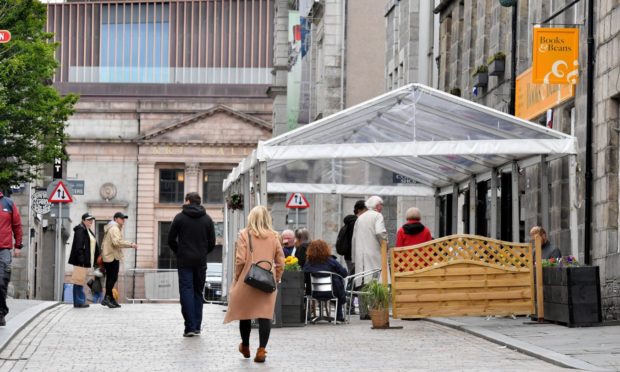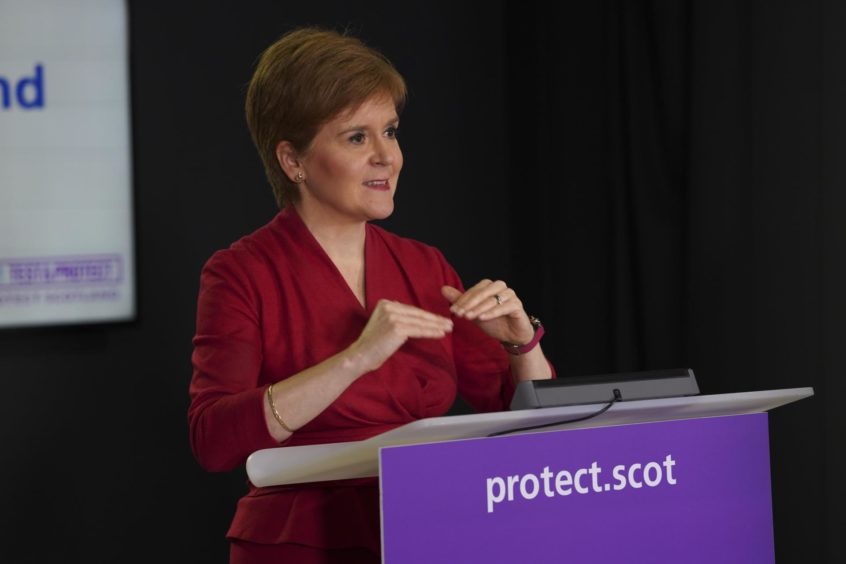Rural areas with relatively low Covid infection rates may have to have the same restrictions imposed on them as cities where the virus is more prevalent, Nicola Sturgeon has warned.
The first minister raised the prospect of areas like Aberdeenshire and Moray enduring the same measures as Aberdeen even if cases drop in the countryside as Scotland moves into the new five-tier system.
At her daily coronavirus briefing, Ms Sturgeon said that factors other than raw coronavirus data such as hospital capacity, the impact of opening pubs and commuting patterns would be looked at when deciding which tier a local authority area is put into.
As things stand, it is expected that Moray will be put into tier one – one above the lowest possible restriction level and which allows indoor socialising of up to six people from two households when the levels are allocated.
In some cases we might have to be more cautious because allowing an area to go to a lower level and then risking an increase when the overall hospital capacity in that health board might already be strained may not be the most sensible thing to do.”
Nicola Sturgeon
Aberdeen City and Aberdeenshire are expected to be put into the stricter tier two, which bars in-home socialising and limits outdoor gatherings to six people from two households.
Aberdeen and Aberdeenshire are being put in the same tier, despite the virus being more widespread in the city (42.4 cases per 100k population over the last week compared with 31.4)
Moray has a lower number of cases per 100,000 population, at 17.7.
But with the three council areas served by NHS Grampian, hospital bed availability and intensive care capacity will inform decision making.
📺 Watch live: First Minister @NicolaSturgeon holds a press conference on #coronavirus (#COVIDー19).
Joining the First Minister today is Scotland’s Interim Chief Medical Officer Dr Gregor Smith. https://t.co/RH9I6QAdQA
— Scottish Government (@scotgov) October 28, 2020
Government aims for ‘balanced judgements’
Speaking generally, Ms Sturgeon said there were “wider contextual issues” to be taken into account in addition to the raw statistics. Those included NHS capacity, the potential impact of loosening hospitality restrictions in an area and the public’s travelling habits.
The first minister said in some instances a local authority may be able to go to a lower tier when its Covid levels were lower than its neighbours.
But on other occasions, it would have to be recognised that people would be travelling to other areas for work, even if advised against doing so.
If a council had more relaxed measures on pub openings, Ms Sturgeon said that could lead to people coming into that local authority area and putting its low levels of the virus at risk.
On the issue of hospitals, she pointed out that no council was “absolutely self-contained” with health boards covering several local authority areas.
“In some cases we might have to be more cautious because allowing an area to go to a lower level and then risking an increase when the overall hospital capacity in that health board might already be strained may not be the most sensible thing to do,” Ms Sturgeon said.
“The raw statistics are absolutely not unimportant but we have to take account of wider contextual issues in coming to a balanced judgements.”
Council leader ‘livid’
Ms Sturgeon used a similar argument when asked about Perth and Kinross councillors’ anger that NHS Tayside is arguing that their local authority should follow Dundee City and be put in the second-strictest category – tier three.
Perth and Kinross Council leader Murray Lyle said he was “livid” at the proposal, which has been made even though his area’s cases per 100,000 stand at 71.7 compared with Dundee’s 210.2.
But Ms Sturgeon said: “Councillors in Perth and Kinross, and I’m not criticising them for this, may feel aggrieved at NHS Tayside for thinking a particular thing.
“But Perth and Kinross residents depend on NHS Tayside hospitals and intensive care units. So they cannot be divorced from that wider health ecosystem. And nor can they simply be plucked out of Tayside.”
Ms Sturgeon added that if pubs had more freedom to open in Perth and Kinross and people from elsewhere in Tayside travelled there then “that potentially exacerbates a situation and it is the same ICU beds and hospital beds that are having to treat people”.

